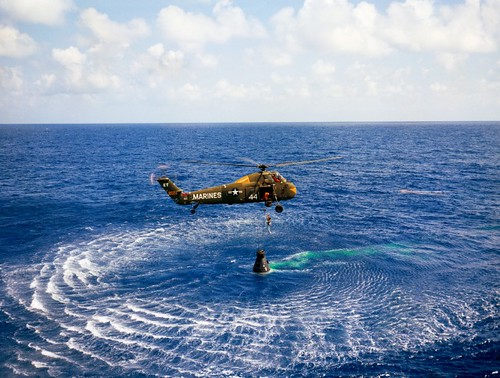May 5, 2011 is the 50th anniversary of Alan Shepard becoming the first American and second person to travel into space.
Shepard was originally slated to perform the mission in October 1960, but unplanned preparatory work delayed the launch so many times that cosmonaut Yuri Gagarin beat him into space on April 12. When he finally got the go-ahead on May 5 for the Mercury-Redstone 3 mission, he said to himself, "Don't [screw] up, Shepard." A paraphrased version of this later became known as "Alan Shepard's Prayer."
The space capsule Freedom 7 launches into space atop a Redstone rocket 50 years ago. NASA photo.
Launch and Recovery Systems Contractors
After the flight, he noted, "It’s a very sobering feeling to be up in space and realize that one’s safety factor was determined by the lowest bidder on a government contract."
The contractors he spoke of included McDonnell Aircraft (which later became McDonnell Douglas, now part of Boeing), which manufactured the Freedom 7 capsule Shepard travelled in. The capsule is now the centerpiece exhibit of the Naval Academy Visitor Center in Annapolis, Md.
The Mercury-Redstone launch vehicle which lofted the Freedom 7 capsule was manufactured by Chrysler and was based on the Redstone liquid-fueled ballistic missile, the most reliable missile at the time.
After the launch and 16-minute mission, a Sikorsky HMM-262 Seabat retrieved Shepard from the Atlantic Ocean, in one of the iconic photos from the mission:
A Marine HMM-262 Seabat helicopter retrieves Alan Shepard after his historic first American manned spaceflight on May 5, 1961. NASA photo.
Human Spaceflight and Computing
Though the launch systems were most visible part of the program, in retrospect, perhaps the most important contractor for the Mercury-Redstone 3 mission was IBM, which was hired to process flight data and to provide mission control with real-time updates and critical flight parameters. Art Cohen, the lead IBM engineer on the project, noted that the mission was "the first real-time data processing entry.
"
A schematic of the Mercury-Redstone Mission. NASA photo.
In Shepard’s 1998 oral history [PDF] of his career, he credited NASA computer work and contract money spent preparing for early missions to setting advanced modern computing technology in motion. While noting that computers would still exist, he said "We wouldn't be at the position we are today without that tremendous [impetus] that NASA had in making the computers."
Commemorating History
NASA celebrated the 50th anniversary of the Mercury-Redstone 3 mission by releasing a stamp yesterday showing Shepard, his space capsule and rocket. Donato Giancola and Phil Jordon were contracted to design the stamp.
In his message commemorating the 50th anniversary, NASA Administrator Charles Bolden singled out contractors, writing, "With our support and assistance, commercial companies will expand access to that rarefied area Alan Shepard first trod for America, allowing NASA to focus on those bigger, more challenging destinations and to enable our science missions to peer farther and farther beyond our solar system."
Submit your own ideas for this day in govcon history to tips@govwin.com.



0 comments:
Post a Comment